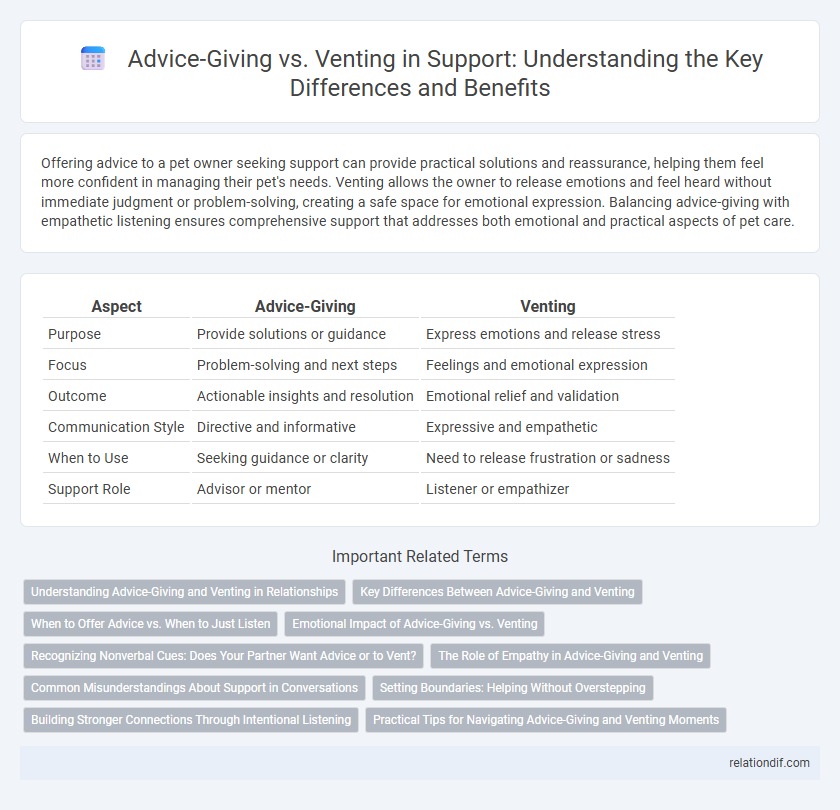Offering advice to a pet owner seeking support can provide practical solutions and reassurance, helping them feel more confident in managing their pet's needs. Venting allows the owner to release emotions and feel heard without immediate judgment or problem-solving, creating a safe space for emotional expression. Balancing advice-giving with empathetic listening ensures comprehensive support that addresses both emotional and practical aspects of pet care.
Table of Comparison
| Aspect | Advice-Giving | Venting |
|---|---|---|
| Purpose | Provide solutions or guidance | Express emotions and release stress |
| Focus | Problem-solving and next steps | Feelings and emotional expression |
| Outcome | Actionable insights and resolution | Emotional relief and validation |
| Communication Style | Directive and informative | Expressive and empathetic |
| When to Use | Seeking guidance or clarity | Need to release frustration or sadness |
| Support Role | Advisor or mentor | Listener or empathizer |
Understanding Advice-Giving and Venting in Relationships
Advice-giving involves offering practical solutions or guidance to help someone resolve a problem, which can enhance problem-solving and empowerment within relationships. Venting allows individuals to express emotions and release stress without immediate solutions, fostering emotional validation and deeper connection. Balancing both approaches encourages empathy and effective communication, crucial for maintaining trust and support in relationships.
Key Differences Between Advice-Giving and Venting
Advice-giving involves offering practical solutions or guidance aimed at resolving a problem, while venting focuses on expressing emotions and frustrations without seeking immediate answers. Advice-giving is solution-oriented and often shifts attention towards problem-solving, whereas venting provides emotional release and validation without judgment. Understanding these key differences helps tailor support strategies to either empower decision-making or foster emotional relief effectively.
When to Offer Advice vs. When to Just Listen
Offer advice when the person explicitly asks for solutions or shows readiness to explore options, ensuring your guidance is relevant and actionable. Just listen when the individual is expressing emotions, seeking empathy, or needs to process feelings without judgment, allowing space for emotional release. Recognizing verbal and nonverbal cues helps determine the appropriate balance between advice-giving and active listening for effective support.
Emotional Impact of Advice-Giving vs. Venting
Advice-giving often provides practical solutions but can unintentionally minimize emotional feelings, leading to frustration or isolation. Venting allows individuals to express emotions freely, promoting emotional release and validation without judgment. Understanding the emotional impact highlights the importance of balancing advice with empathetic listening to effectively support others.
Recognizing Nonverbal Cues: Does Your Partner Want Advice or to Vent?
Recognizing nonverbal cues such as body language, facial expressions, and tone of voice helps determine if your partner wants advice or simply to vent. When they avoid eye contact or sigh deeply, they may be seeking emotional release rather than solutions. Observing these subtle signals improves communication and strengthens support effectiveness in relationships.
The Role of Empathy in Advice-Giving and Venting
Empathy plays a critical role in both advice-giving and venting by fostering understanding and emotional connection between individuals. In advice-giving, empathy helps tailor recommendations to the recipient's feelings and circumstances, enhancing the relevance and effectiveness of the guidance. During venting, empathy validates emotions without judgment, creating a safe space for expression that can alleviate stress and promote emotional healing.
Common Misunderstandings About Support in Conversations
In support conversations, advice-giving is often mistaken for being helpful when the person may primarily need to vent and feel heard. Many misunderstand that offering solutions too quickly can shut down emotional expression and hinder genuine connection. Recognizing the difference between providing advice and simply listening improves support effectiveness and emotional validation.
Setting Boundaries: Helping Without Overstepping
Setting clear boundaries when offering support ensures that advice-giving respects the recipient's autonomy while venting provides a safe space for emotional release. Balancing these approaches prevents overstepping by recognizing when to listen empathetically or suggest actionable solutions. This boundary-setting fosters trust and maintains healthy communication dynamics in supportive relationships.
Building Stronger Connections Through Intentional Listening
Intentional listening fosters stronger connections by focusing on understanding rather than immediately offering advice or simply venting emotions. This approach validates feelings and encourages open communication, which deepens trust and empathy between individuals. Prioritizing active listening over quick solutions leads to more meaningful and supportive relationships.
Practical Tips for Navigating Advice-Giving and Venting Moments
Recognize when someone seeks advice versus emotional support by paying attention to verbal and nonverbal cues, ensuring your response matches their need. Offer practical suggestions only after validating their feelings during venting moments to build trust and understanding. Set clear boundaries by asking if advice is welcomed before sharing solutions, fostering a supportive and respectful conversation.
Advice-giving vs venting Infographic

 relationdif.com
relationdif.com